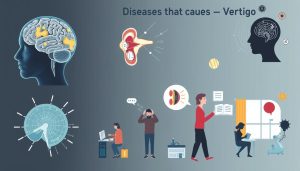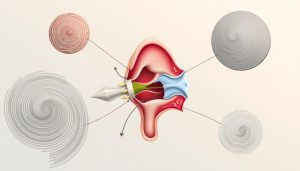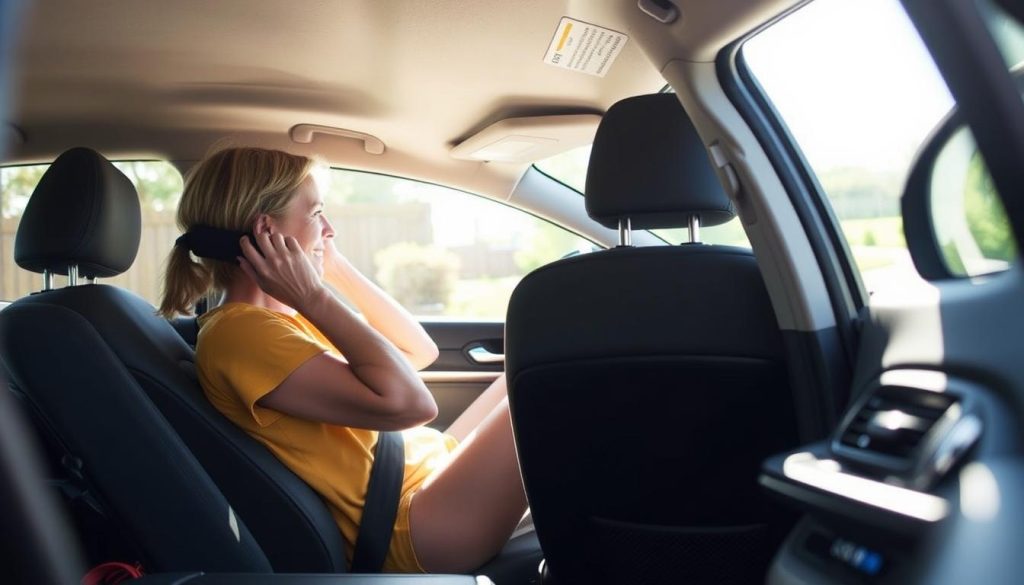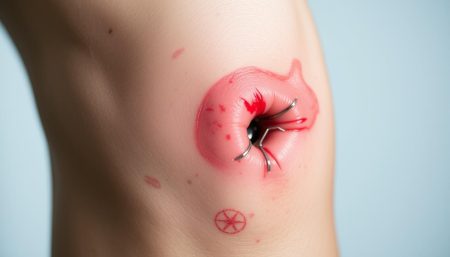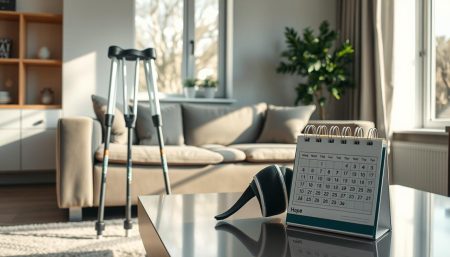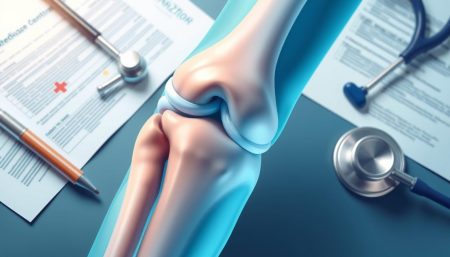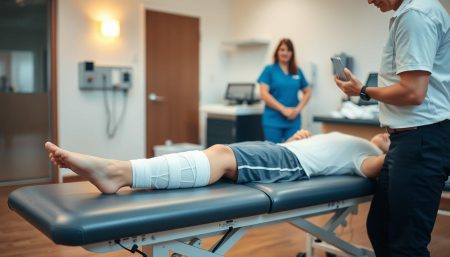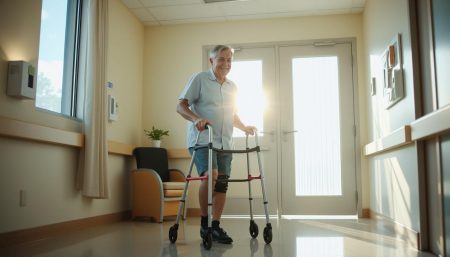The journey through knee replacement recovery is filled with important milestones. One of these is when you can start driving again. This is a big step towards getting back to normal life.
Doctors and experts take this question very seriously. They want to make sure you can drive safely. This means you’ve fully recovered and can handle the road safely.
This article aims to give you all the details on when can I drive after knee replacement surgery. We’ll look at all the factors that affect your return to driving.
Understanding Knee Replacement Surgery and Post-Operative Care
Knee replacement surgery is a big help for those with severe joint damage. It raises questions about knee surgery driving guidelines and knee replacement recovery time driving. The surgery replaces damaged parts of the knee with artificial ones to improve mobility and reduce pain.
After surgery, the right care is key for a good recovery. It affects when you can start driving again. A careful rehabilitation program is needed to build strength and make sure the new joint lasts long. Knowing what to expect in post-operative care helps manage recovery hopes.
Right after surgery, it’s important to listen to your doctor’s advice closely. You’ll start with light exercises and slowly move more under a doctor’s watch. Following these steps helps in a smoother recovery and affects when you can drive again.
Many wonder when they can start driving after surgery. It’s not just about driving; it’s also about being safe and not in too much pain. Every person recovers differently. But, talking to your orthopedic surgeon about driving after knee surgery is a good idea.
Here’s a look at what recovery and driving might look like after knee replacement surgery:
- Initial recovery: Focus on reducing swelling and pain while starting light ambulation.
- Secondary recovery: Continued physical therapy to strengthen the knee and improve flexibility.
- Long-term recovery: Gradual return to more strenuous activities and eventual driving when medically cleared.
Knowing about recovery helps set realistic goals and follow the care needed after surgery. Talking to doctors about knee surgery driving guidelines is important for safety and avoiding problems during recovery.
How Long After Knee Replacement Can You Drive
Many patients worry about when they can drive again after knee replacement surgery. The time it takes to start driving again varies. It depends on how well you heal and the advice from your doctor.
Driving after knee replacement isn’t just about waiting a certain amount of time. You also need to be able to control your legs and feel comfortable. This is a big step in getting better.
| Phase | Driving Readiness Indicator |
|---|---|
| Initial Recovery (0-3 weeks) | Not recommended; focus on healing and reducing swelling. |
| Mid-Recovery (4-6 weeks) | Possible short-distance driving if pain is manageable, and reaction times are normal. |
| Post Recovery (6 weeks and beyond) | Gradual return to usual driving habits, pending physician’s approval. |
Knee replacement driving restrictions are there to keep you safe. They help prevent accidents caused by mobility or reaction issues. Always talk to your doctor for advice tailored to you.
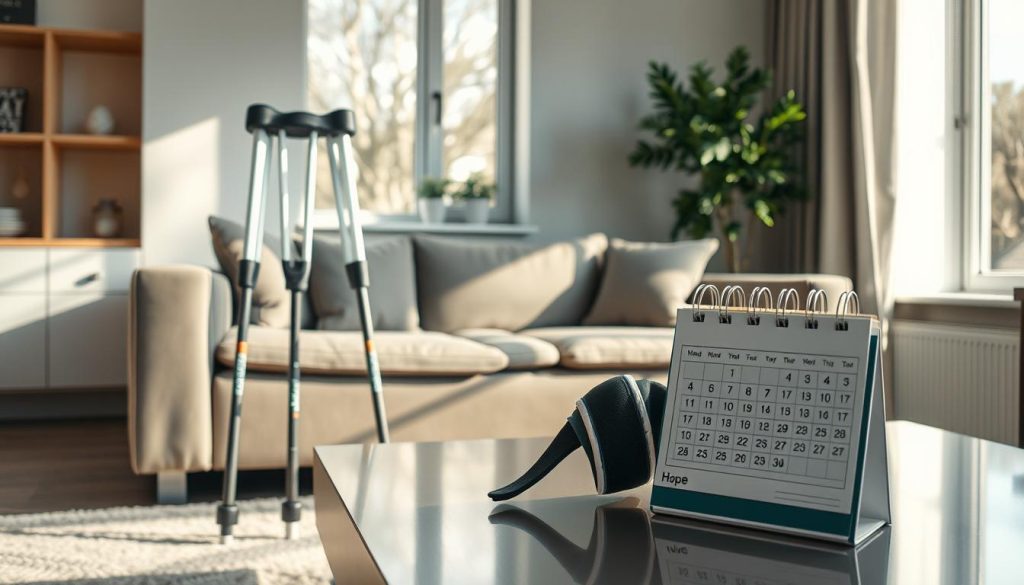
Deciding when to start driving again should be a team effort. Talk to your orthopedic team. They will check your knee’s strength, flexibility, and if you’re ready to drive.
Factors Influencing Your Ability to Drive Post-Surgery
After knee replacement surgery, knowing when you can drive again is key. Many things, like medicine, physical therapy, and how fast you heal, affect your driving. It’s important to think about these to feel safe and confident driving again.
Medication and Its Effects on Driving
Medicine after surgery helps with pain but can also affect driving. Drugs like sedatives and opioids can slow down your reactions and make you less alert. This can make it hard to drive safely. Finding the right medicine is important to stay safe on the road.
Physical Therapy and Regaining Muscle Control
Physical therapy is key to getting your muscles strong again. It helps you do things like brake and accelerate safely. With therapy, you can get back to driving faster, meeting your driving goals.
Individual Healing Rates and Knee Recovery
Everyone heals at their own pace. Things like age, health, and the knee’s condition before surgery affect how fast you can drive again. It’s important to watch your healing and get advice before driving to follow driving limits.
| Factor | Impact on Driving | Typical Recovery Time |
|---|---|---|
| Medication | Impairs cognitive and motor abilities | Varies based on drug type and dosage |
| Physical Therapy | Improves muscle strength and coordination | 6-12 weeks |
| Personal Healing | Variable based on individual health factors | 4-10 weeks |
Assessing Mobility and Comfort: Key Considerations
It’s important to check if you can move well and feel comfortable before you start driving again after knee surgery.
Look at how well you can move your leg and control the car. These things show if you’re ready to drive safely.
- Range of Motion: Can you bend and straighten your knee to use the pedals?
- Strength and Stability: Do you have enough leg strength to control the car?
- Pain Management: Can you handle the pain while driving?
Talking to a doctor is key to know when it’s okay to drive again. How long you wait to drive after knee surgery depends on many things. It’s different for everyone.
| Mobility Feature | Assessment Criteria | Importance |
|---|---|---|
| Leg Flexibility | Can you bend your knee enough to press the pedals smoothly? | High |
| Strength | Do you have enough muscle power to control the pedals on long drives? | Medium |
| Pain Threshold | Do you feel little pain while sitting and driving? | High |
Getting better at these things through physical therapy can help you drive again. You might get special exercises and programs to help you.
Always talk to a doctor before you start driving again. It’s a big responsibility that needs you to be sharp and ready. You should only drive when you’re sure your knee is okay and you can handle the road.
Knee Replacement Recovery Time Driving: What to Expect
Recovering from knee replacement surgery takes careful planning. It’s important to follow the advised timelines, including when to start driving again. Knowing the stages of recovery helps patients understand when can I drive after knee replacement surgery and what’s involved in knee replacement recovery driving.
Early Stage Recovery: The First Weeks
In the first weeks after surgery, healing and reducing inflammation are the main goals. Mobility is very limited, and driving is usually not allowed. This is to prevent strain and ensure proper healing. Regular check-ups with the healthcare provider are key at this stage.
Intermediate Stage: Returning to Normal Activities
By 4-6 weeks, patients may start doing more activities, including driving. Always get clearance from your healthcare provider before driving again. At this stage, assessments focus on knee flexibility, strength, and safe driving ability.
Long-Term Recovery and Ongoing Care Needs
Long-term care focuses on keeping the knee joint healthy and maintaining physical fitness. Depending on recovery and the other knee’s condition, patients might need additional therapies or exercises. Continuous attention to joint care and recommended physical activities is essential for long-term knee health.
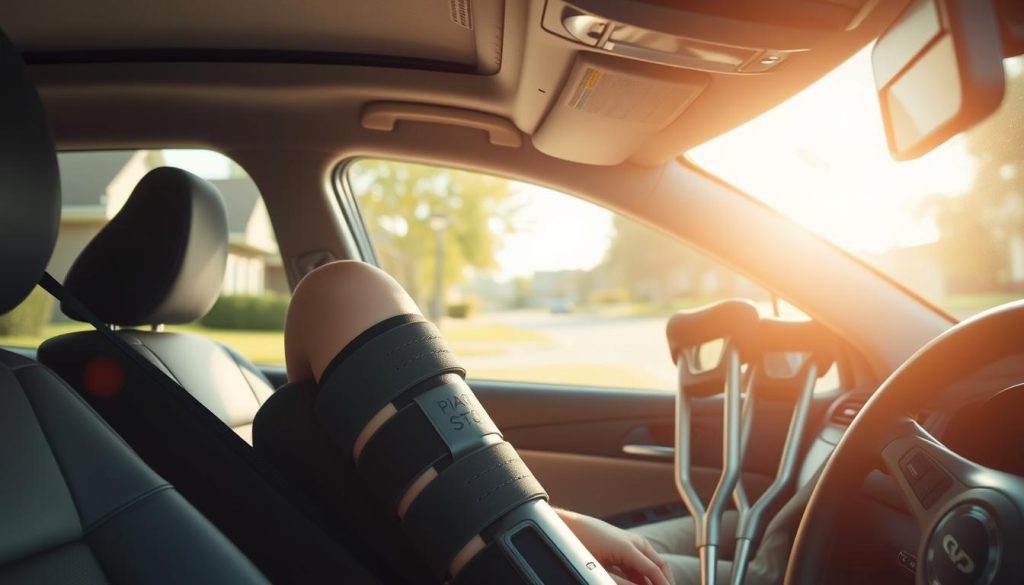
The Role of Physical Therapy in Resuming Driving
Resuming driving after knee surgery is a big step in recovery. Knee surgery driving guidelines and driving limitations after knee replacement guide this process. Physical therapy is key to getting the strength and confidence needed to drive safely.
Physical therapists work on strengthening the muscles around the knee. They also improve flexibility and range of motion. This is important for basic driving tasks like braking and accelerating.
They use various exercises to help restore muscle control and reduce discomfort while driving.
- Therapeutic exercises to enhance joint movement
- Strengthening techniques for lower body stability
- Pain management strategies to tolerate longer sitting periods
Physical therapists also give personalized advice based on each patient’s healing stage. This ensures patients don’t rush and risk injury. Here’s a typical recovery progression:
| Weeks Post-Operation | Mobility Goal | Therapy Focus |
|---|---|---|
| 1-3 | Initial healing and controlled movement | Pain management, gentle exercises |
| 4-6 | Increased knee flexibility | Strength training, joint mobilization |
| 7+ | Restoration of driving activities | Driving simulation exercises, ergonomic advice |
Therapists play a big role in both physical and mental recovery. They help patients feel confident and safe behind the wheel. Regular checks ensure patients meet driving limitations after knee replacement guidelines and gain the confidence to drive.
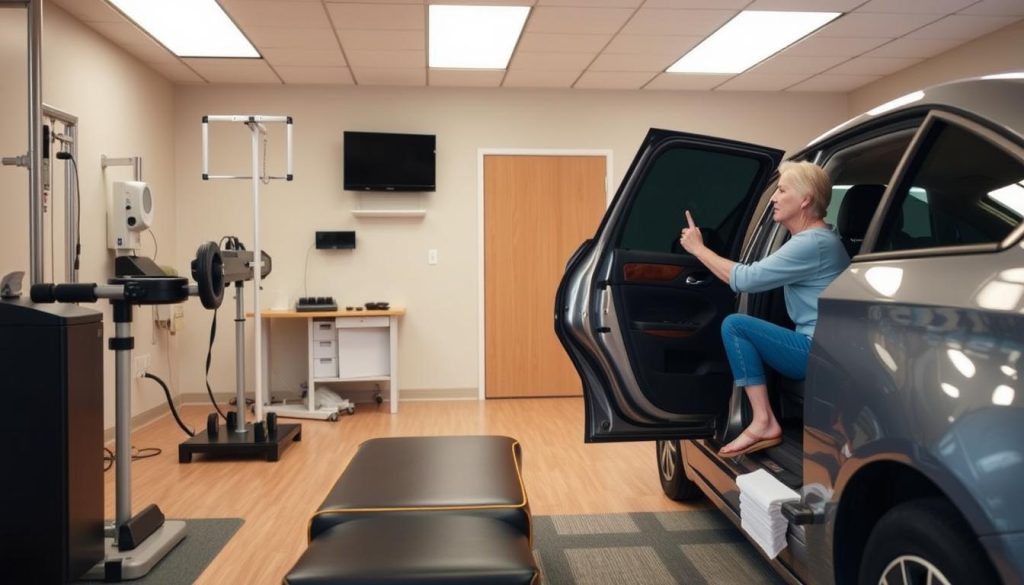
Following a physical therapist’s recovery plan is important for safe and quick return to driving after knee surgery. This ensures a successful and lasting transition back to driving.
Knee Replacement Driving Restrictions Explained
It’s important to know the rules about driving after knee surgery and following knee replacement driving restrictions. These rules help keep everyone safe and make sure patients follow their doctor’s advice. They are set by healthcare experts to guide patients during their recovery.
Legal Considerations and Liability
Driving before getting the okay from a doctor can lead to big legal problems. If an accident happens, the person driving might be blamed. So, it’s key for knee replacement patients to understand the legal side of driving too soon.
Advice from Orthopedic Surgeons
Orthopedic surgeons give important advice on when it’s okay to start driving again. They look at how much pain the patient is in, how well they can move, and if they’re stable enough. It’s not just about reaching certain recovery points. It’s also about being able to drive safely without pain or worry.
In the end, driving after knee surgery is based on how well each person recovers. Following knee replacement driving restrictions helps avoid getting hurt again and keeps everyone safe on the road.
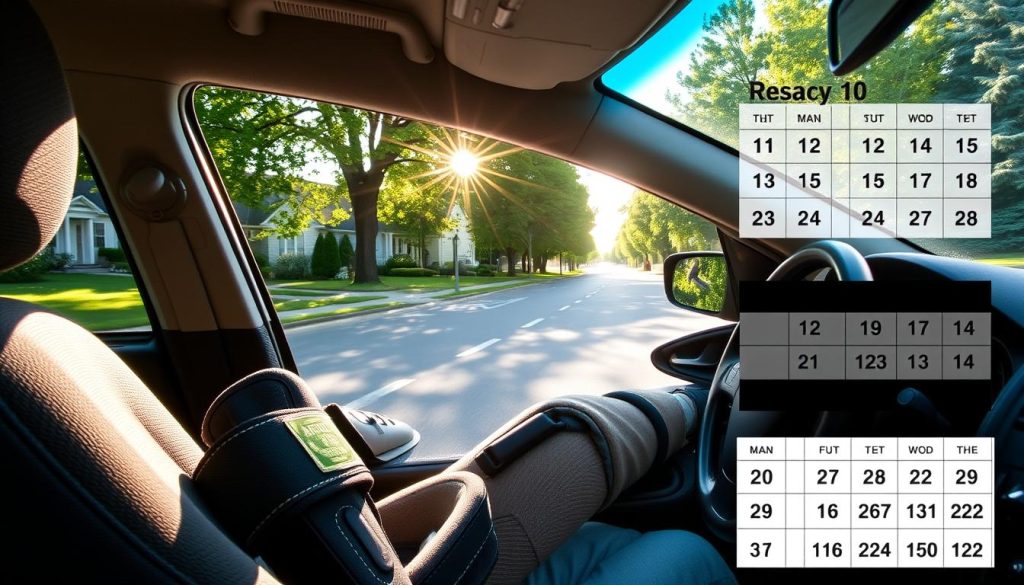
Practical Tips for Driving After Knee Replacement
After knee replacement surgery, getting back to driving is a big step. It’s important to know about knee replacement recovery time driving to drive safely. This section offers tips to help you get back to driving smoothly.
First, always listen to your doctor about when to start driving again. They usually say wait until you can get in and out of the car easily. You should also be able to stop quickly without pain.
- Adjust the seat to avoid knee strain, giving enough room for your leg.
- Use a plastic bag on the seat to help you turn more easily.
- Start with short drives to avoid straining your knee too much.
- Choose routes with fewer stops to reduce knee strain.
It’s also key to do exercises that strengthen and stretch your knee. Here’s a table with exercises that help during recovery.
| Exercise Type | Description | Frequency |
|---|---|---|
| Knee Flexibility | Gentle stretching to increase the range of motion | Daily |
| Strength Building | Low-impact exercises like stationary cycling or swimming | 3-4 times a week |
| Endurance Enhancements | Progressive walking, gradually increasing distance | 5 times a week |
Doing these exercises daily can improve your knee’s strength and flexibility. This helps you drive better after knee replacement.
The main goal is to drive safely and comfortably. Being patient and following these tips can help you recover well. Also, don’t forget to see your doctor regularly to check on your progress and when you’re ready to drive.
When Can I Drive After Knee Replacement Surgery: Personal Stories
Getting back to driving after knee replacement surgery is a big step in recovery. It’s important to know when and how people regain their freedom. Here, we share personal stories and expert advice on knee replacement recovery driving.
Case Study: A Patient’s Road to Recovery
A patient had a right knee replacement and wondered how long after knee replacement can you drive. They followed medical advice and waited until they felt ready, driving four weeks later. Stopping narcotic pain meds was key to driving safely again.
Real-Life Experiences: Testimonials and Advice
- A retired school teacher said driving again made them feel normal and independent, which helped their mental health.
- An avid golfer used adaptive devices in their car to make driving easier and safer.
For more on when you can drive after surgery, check out this article at this resource.
| Weeks Post-Surgery | Patient Ability | Doctor’s Advice |
|---|---|---|
| 2 Weeks | Limited, with assistance | Focus on healing, not driving |
| 4 Weeks | May start short distances if feeling capable | Ensure off narcotics and get a physician’s clearance |
| 6 Weeks | Generally cleared for driving | As long as patient feels comfortable |
Recovery times vary, showing how personal knee replacement recovery driving is. It’s important to follow your body’s healing and your doctor’s advice, as explained in another helpful article found here.
Driving Limitations After Knee Replacement: Safety First
After knee replacement surgery, knowing when you can drive again is key. It’s important for your safety and others on the road. Doctors say it’s not safe to drive too soon because your knee might not work right.
Driving after knee surgery needs careful planning. Doctors give advice to avoid accidents. They want you to stay safe and not risk hurting yourself or others.
- When you can drive again depends on how well you recover and the surgery type.
- Getting your knee strong and flexible through therapy is a must before driving.
- Think about your car too. You might need to make changes to fit your new driving needs.
There are also safety steps to follow when driving after knee surgery:
| Consideration | Detail | Timeline |
|---|---|---|
| Medical Clearance | Get a doctor’s okay that says you’re ready to drive. | 4-6 weeks post-surgery |
| Pain Management | Make sure your pain is under control to drive safely. | Ongoing assessment |
| Vehicle modifications | Make any needed changes to your car for safe driving. | Before driving |
It’s important to follow the rules for driving after knee surgery. This helps avoid accidents. By doing so, you can drive safely and with confidence again.
Knee Surgery Driving Guidelines from Healthcare Providers
Driving after knee surgery is a big step in getting better. Patients want to drive again and be independent. They need to follow specific rules, which change based on the surgery type. Doctors stress the need for personal advice to stay safe while driving.
Specific Recommendations Based on Surgery Type
Every knee surgery is different, affecting how soon you can drive. For instance, after a total knee replacement, you might need to wait longer than after arthroscopic surgery. Doctors will check your movement, strength, and pain before saying it’s okay to drive.
The Importance of Follow-Up Appointments
Regular check-ups are key to knowing when you can drive again. At each visit, your doctor will look at your progress and adjust your plan if needed. This makes sure you’re ready to drive safely and without risk to others.
It’s vital to follow your doctor’s advice on when to start driving again. Driving too soon can slow down your healing or even cause accidents. Each guideline is made with your health and safety in mind, helping you feel confident about getting back to your life.
Assistive Devices and Vehicle Modifications for Safer Driving
Starting to drive again after knee replacement surgery means thinking about assistive devices and car changes. These help make driving safer and more comfortable. New technology offers many options to help people stay independent and safe.
Car changes can be simple, like supportive seats, or more complex, like hand controls. Hand controls let drivers use their hands for the brake and gas, easing knee stress. Left-foot accelerators are also an option for those with a replaced right knee, using the stronger leg.
Talking to rehab specialists is key to finding the right car changes. They know how knee surgery recovery works and can suggest the best options. With the right advice and gear, people can feel confident and independent again.
FAQ
Q: When can I drive after knee replacement surgery?
A: The time you can drive after knee surgery varies. It depends on how fast you heal and if you can drive safely. Doctors usually say wait 4 to 6 weeks. But, it’s best to listen to your own body and your doctor’s advice.
Q: What does knee replacement surgery entail, and how does it affect driving?
A: Knee replacement surgery replaces the damaged joint with an artificial one. This helps with pain and movement. Right after surgery, you shouldn’t drive because of pain, limited movement, and medication effects. Following your doctor’s care plan is key to getting back to driving.
Q: What are some typical knee replacement driving restrictions?
A: There are rules to follow for safe driving after surgery. You can’t drive on pain meds, need good leg control, and can’t be in too much pain. Your doctor will give you specific advice on when it’s okay to drive again.
Q: How do medication and physical therapy influence when I can start driving again?
A: Medications can make you less alert and unsafe to drive. Wait until you’re off these meds. Physical therapy helps you regain muscle and joint control needed for driving. Sticking to your physical therapy plan can help you get back to driving faster.
Q: When assessing mobility and comfort, what should be considered before returning to driving?
A: You need to be able to get in and out of the car easily. Your leg should bend enough to sit comfortably and have enough strength for emergency stops. Always check with your doctor to make sure you’re ready to drive safely.
Q: Can you break down knee replacement recovery into stages as they relate to driving?
A: Recovery has early, middle, and long-term stages. In the early stage, you shouldn’t drive. In the middle stage, you might start doing normal things and think about driving. In the long term, most people can drive again as they get closer to full recovery.
Q: What role does physical therapy play in resuming driving post-knee replacement?
A: Physical therapy is very important for your recovery. It helps strengthen your knee and improve flexibility. A physical therapist will help prepare your knee for driving and tell you when you’re ready.
Q: What legal considerations and possible liability should I be aware of when driving after knee surgery?
A: You must be sure you can drive safely and aren’t affected by meds or mobility issues. If you drive too soon and cause an accident, you could be held responsible. Always follow your doctor’s advice and think about the risks before driving.
Q: Can you offer practical tips for adjusting to driving after knee replacement?
A: Focus on comfort and safety when driving after surgery. Use cushions, adjust the seat, and start with short trips. Make sure you can reach the pedals and steering wheel easily, and practice getting in and out of the car.
Q: How do personal stories help others who are preparing to drive after knee replacement surgery?
A: Personal stories offer real-life advice and encouragement. They make the recovery journey more relatable. Hearing how others have returned to driving can give you valuable tips and remind you to be patient and follow your doctor’s advice.
Q: What safety considerations should I keep in mind when driving post-knee replacement surgery?
A: Safety first means being off pain meds that affect driving, having enough knee strength, and not being in pain. Always listen to your doctor to know when you’re ready to drive again.
Q: What specific driving guidelines do healthcare providers recommend after knee surgery?
A: Doctors suggest waiting until you’re off certain meds, have good mobility, and get their okay. They might also advise avoiding heavy traffic or long drives until you’re fully confident and able.
Q: Are there assistive devices or vehicle modifications that can aid in safer driving after knee replacement?
A: Yes, there are devices and modifications like pedal extenders and hand controls that can help. Talk to rehabilitation specialists to find the best options for your situation.




